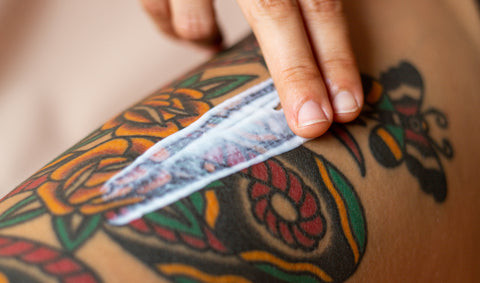Getting a new tattoo is an exciting experience, but understanding the healing process is crucial for ensuring your ink looks its best and remains healthy. One of the most common questions for tattoo newbies and veterans alike is: “How long does it take for tattoos to heal?”. If you’re wondering about timelines, scabbing, and aftercare, you’ve come to the right place. Let’s delve into the tattoo healing journey to set your expectations and guide you through each stage.
Understanding the Tattoo Healing Timeline
Think of a tattoo as a controlled wound. While the artistry is permanent, the initial application process creates thousands of tiny punctures in your skin. Your body’s natural response is to heal this “wound,” and this healing process occurs in distinct stages. Understanding these stages helps you gauge what’s normal and when to be concerned.
Generally, the tattoo healing process can be broken down into these phases:
-
Week 1: The Initial Days (Inflammation and Oozing): Immediately after getting tattooed, you can expect redness, swelling, and tenderness. This is your body’s inflammatory response kicking in. You might notice some oozing of plasma, blood, and excess ink. This is normal. During this phase, keeping the tattoo clean and following your artist’s initial aftercare instructions is paramount.
-
Week 2-3: Scabbing and Itching: As the tattoo starts to heal, scabs will likely form. Scabbing is a protective mechanism, preventing bacteria from entering the wound. Itching is also common during this phase as new skin cells regenerate. It’s crucial to resist the urge to pick or scratch at the scabs, as this can damage the tattoo and increase the risk of infection and scarring.
-
Week 3-4: Peeling and Flaking: After the scabs have done their job, they will begin to flake and peel off, similar to a sunburn. The skin might look milky or cloudy during this stage. Continue moisturizing and avoid picking at the peeling skin. Let it come off naturally.
-
Months 2-6: Full Healing and Settling: While the surface of your tattoo might appear healed within a month, the deeper layers of skin are still regenerating. The colors will become more vibrant and the tattoo will settle into your skin. Full healing, where all layers of skin are completely recovered, can take anywhere from 4 to 6 months, sometimes longer depending on individual factors and tattoo size.
 Woman with tattoos smiling
Woman with tattoos smiling
Factors Influencing Tattoo Healing Time and Scabbing
The duration and intensity of scabbing, as well as the overall healing time, can vary significantly from person to person and tattoo to tattoo. Several factors play a role:
-
Tattoo Size and Complexity: Larger tattoos, particularly those with heavy shading and color packing, are more extensive wounds and naturally take longer to heal. Intricate designs with fine lines might heal faster than solid, bold pieces.
-
Tattoo Placement: Areas of the body with more friction or movement, such as hands, fingers, feet, and joints, can experience slower healing due to constant flexing and rubbing against clothing. Areas with more fatty tissue and less blood circulation might also heal slower. Conversely, areas with good blood flow tend to heal quicker.
-
Individual Healing Ability: Just like any wound, your body’s inherent healing capabilities play a significant role. Factors like age, genetics, immune system health, and pre-existing medical conditions can influence how quickly you heal. People with stronger immune systems and healthier lifestyles generally heal faster.
-
Aftercare Practices: This is arguably the most crucial factor you can control. Diligent and proper aftercare, as advised by your tattoo artist, can significantly expedite healing and minimize complications like excessive scabbing or infection. Conversely, neglecting aftercare can drastically prolong healing time and increase risks.
-
Tattoo Artist Technique: A heavy-handed tattoo artist can cause more trauma to the skin, leading to more significant scabbing and potentially longer healing times. Experienced artists are usually skilled in techniques that minimize skin trauma.
Scabbing: What’s Normal and When to Worry?
Scabbing is a common and generally normal part of tattoo healing. It’s a sign that your body is working to protect the wound and repair the skin. However, it’s essential to distinguish between normal scabbing and signs of potential complications.
Normal Tattoo Scabbing:
- Thin and Flexible: Normal scabs are usually thin, resembling dried skin or flakes. They might be the color of dried lymph fluid or slightly tinted with tattoo ink.
- Adhered at the Edges: They should be attached mainly at the edges and gradually lift as the skin underneath heals.
- Not Excessive: The scabbing shouldn’t be excessively thick or widespread.
- Accompanied by Itching: Mild to moderate itching is normal as the skin heals.
Abnormal Tattoo Scabbing and Signs of Potential Infection:
While some scabbing is expected, watch out for these signs that could indicate a problem requiring attention:
- Thick, Raised, or Hard Scabs: Scabs that are excessively thick, raised significantly above the skin, or feel hard might indicate deeper trauma or potential issues.
- Excessive Redness and Swelling: While initial redness and swelling are normal, persistent or worsening redness and swelling around the tattoo area beyond the first few days can be a sign of infection.
- Pus or Drainage: Any discharge of yellowish or greenish pus from the tattoo is a clear indication of infection.
- Fever or Chills: Systemic symptoms like fever, chills, or feeling unwell alongside tattoo issues should be addressed by a medical professional immediately.
- Increasing Pain: While some tenderness is expected, escalating pain that doesn’t subside or becomes throbbing could be a sign of infection.
- Foul Odor: An unpleasant smell emanating from the tattoo area is another red flag for infection.
If you experience any of these abnormal signs, it’s crucial to contact your tattoo artist or seek medical advice promptly. Early intervention can prevent complications and ensure proper healing.

Essential Tattoo Aftercare Tips for Optimal Healing
Proper aftercare is non-negotiable for ensuring your tattoo heals well, quickly, and with minimal scabbing or complications. Here are key aftercare practices to follow:
- Keep it Clean: Gently wash your tattoo twice a day with mild, fragrance-free antibacterial soap and lukewarm water. Pat it dry with a clean paper towel or let it air dry.
- Moisturize Regularly: After washing and drying, apply a thin layer of tattoo-specific aftercare cream or a fragrance-free, hypoallergenic moisturizer. Avoid over-moisturizing, as this can suffocate the skin.
- Avoid Sun Exposure: Sunlight is the enemy of healing tattoos. It can cause fading and damage. Keep your new tattoo completely covered and out of direct sunlight for several weeks. Once healed, always use sunscreen on your tattoo to protect its vibrancy.
- Wear Loose Clothing: Tight clothing can rub against your new tattoo, causing irritation and hindering healing. Opt for loose, breathable fabrics.
- Stay Hydrated and Healthy: Drinking plenty of water and maintaining a healthy lifestyle supports your body’s natural healing processes.
- Avoid Soaking: Refrain from swimming, baths, saunas, and hot tubs until your tattoo is fully healed, as soaking can introduce bacteria and interfere with healing. Showers are fine, but avoid prolonged water exposure.
- Resist Touching and Picking: As tempting as it might be, avoid touching your tattoo unnecessarily and never pick at scabs or peeling skin. Let them come off naturally.
Dos and Don’ts Summary During Scabbing Phase:
Do:
- Leave it alone and let it heal naturally.
- Maintain a balance between moisture and dryness.
- Allow minimal water exposure during showers.
- Consult your tattoo artist if you have concerns.
Don’t:
- Pick at scabs.
- Scratch your tattoo.
- Rub scabs dry with a towel.
- Submerge your tattoo in water for extended periods (swimming, baths).
 Tattoo aftercare
Tattoo aftercare
Patience is Key
While the initial scabbing phase typically lasts around a week, remember that tattoo healing is a marathon, not a sprint. Full healing takes time, and patience is paramount. By understanding the stages, recognizing normal vs. abnormal scabbing, and diligently following aftercare instructions, you’ll be well-equipped to ensure your tattoo heals beautifully and remains a source of pride for years to come. And if you are looking for top-quality aftercare products to aid your tattoo’s healing journey, consider exploring options like the Stories & Ink Aftercare Duo for a gentle and effective approach to tattoo aftercare.